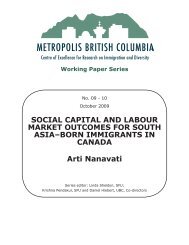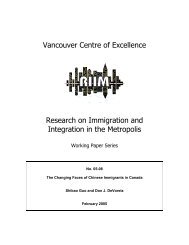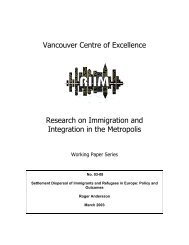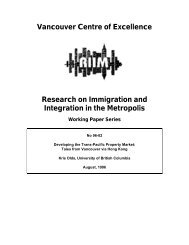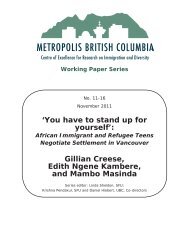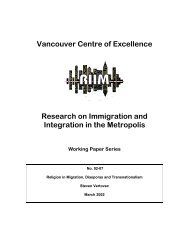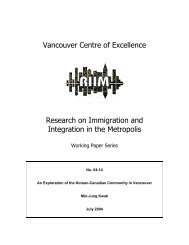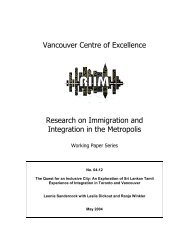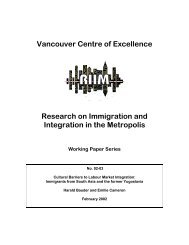Characteristics of Immigrant Transnationalism in ... - Metropolis BC
Characteristics of Immigrant Transnationalism in ... - Metropolis BC
Characteristics of Immigrant Transnationalism in ... - Metropolis BC
Create successful ePaper yourself
Turn your PDF publications into a flip-book with our unique Google optimized e-Paper software.
7<br />
Delta, a distant work<strong>in</strong>g-class suburb <strong>in</strong> the southeast quadrant <strong>of</strong> metropolitan Vancouver that houses a<br />
large South Asian population. 2 The survey was conducted by telephone by a specialized market<strong>in</strong>g<br />
company that employed <strong>in</strong>terviewers able to work <strong>in</strong> English plus Canonese, Mandar<strong>in</strong>, Punjabi, H<strong>in</strong>di,<br />
and Tagolog. Most recent immigrants chose to be <strong>in</strong>terviewed <strong>in</strong> their native language while the<br />
opposite was true <strong>of</strong> those who had been settled at least 10 years. Interviews were conducted with an<br />
adult family member who received the call. Consequently <strong>in</strong>terviews <strong>in</strong>cluded family dependents as<br />
well as the pr<strong>in</strong>cipal wage earner. Among the sample 944 were <strong>in</strong> the labour force.<br />
The survey was extensive and covered a variety <strong>of</strong> topics, <strong>in</strong>clud<strong>in</strong>g household and family<br />
structure, employment, <strong>in</strong>come, immigration history, demographic characteristics <strong>of</strong> the respondent<br />
(age, sex, ethnicity, place <strong>of</strong> birth), quality <strong>of</strong> neighbourhood life, perceived discrim<strong>in</strong>ation, attitudes<br />
toward immigration and multiculturalism, citizenship, satisfaction with Canada, and transnational<br />
activities. In this chapter we concentrate on the transnational module <strong>of</strong> the survey, and tabulate results<br />
on this dimension with the socio-economic, demographic, and immigrant status <strong>of</strong> respondents.<br />
Results<br />
We beg<strong>in</strong> with a brief enumeration <strong>of</strong> the answers to ten questions about transnational behaviour (Table<br />
1). As might be expected, a large proportion <strong>of</strong> our respondents have friends and relatives who rema<strong>in</strong><br />
<strong>in</strong> their country <strong>of</strong> orig<strong>in</strong>, and nearly all keep <strong>in</strong> touch with them. Contact <strong>in</strong> most cases takes place<br />
either weekly or monthly, though a small number ma<strong>in</strong>ta<strong>in</strong> daily communication. The vast majority<br />
utilize electronic means <strong>of</strong> communication, especially the telephone, though a high number also uses e-<br />
mail. It appears that the postal system has receded <strong>in</strong> significance, with only one <strong>in</strong> five immigrants<br />
mention<strong>in</strong>g this form <strong>of</strong> communication. 3 Approximately two-thirds <strong>of</strong> those who answered our survey<br />
travel to their pre-migration country. Of those, the majority do so irregularly, less than once a year.<br />
However, one-quarter travel once a year or so, and one <strong>in</strong> five make this journey on a more frequent<br />
basis. There is also considerable <strong>in</strong>teraction <strong>in</strong> the opposite direction: over 60 percent host visitors from<br />
their home country. As before, this travel occurs regularly (at least once per year) for about half <strong>of</strong> the<br />
respondents, and more occasionally for the others.<br />
1 We deliberately oversampled immigrants by approximately double, relative to their proportion <strong>of</strong> the total<br />
population. A detailed discussion <strong>of</strong> the sampl<strong>in</strong>g methodology, <strong>in</strong>clud<strong>in</strong>g a summary <strong>of</strong> the complete survey<br />
<strong>in</strong>strument, can be found <strong>in</strong> Hiebert 2003.<br />
2 Full descriptions <strong>of</strong> these areas can be found <strong>in</strong> Hiebert et al 1998; the social geography <strong>of</strong> immigrant settlement<br />
<strong>in</strong> Vancouver is addressed <strong>in</strong> Hiebert 1999.<br />
3 Respondents were given a list <strong>of</strong> communication methods and asked to identify all that apply. The vast majority<br />
<strong>in</strong>dicated only one or two methods and only two were coded for analysis. The figures <strong>in</strong> the table therefore add up<br />
to more than 100 percent <strong>of</strong> respondents.



